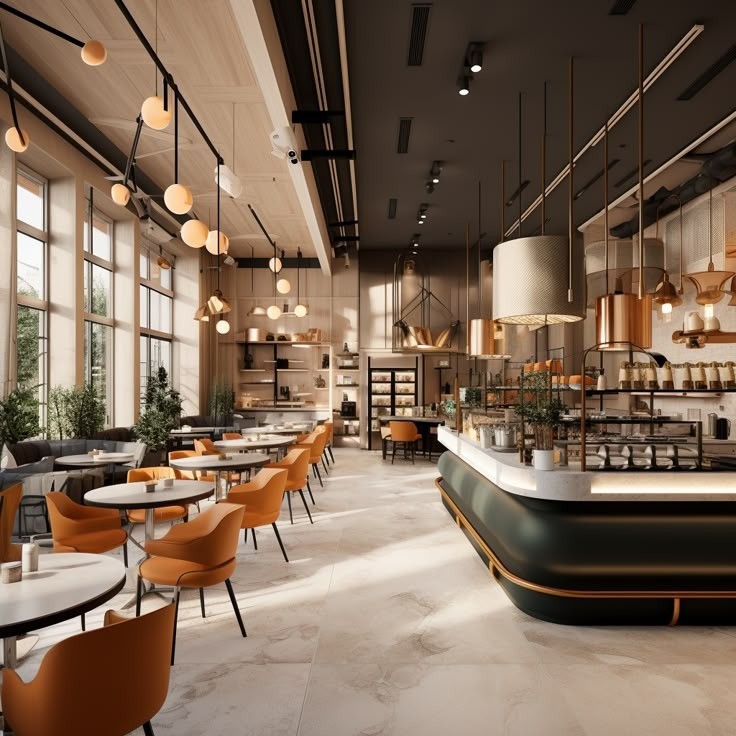Cafe Design: Crafting Atmosphere and Experience

Cafe design is not just about interior layout; it is the art of creating an atmosphere. It requires an architectural narrative that captivates the user, appeals to the senses, and makes the time spent in the space valuable. The organization of volumes, the balance of light and shadow, material choices, and spatial flow are components that directly impact how visitors experience the space.
1. Defining the Spatial Organization
The most important step in cafe design is determining the spatial organization. Depending on the size of the space and the concept, decisions should be made to direct user movement and ensure the flow of the space.
-
Entrance and Reception Area:
-
This area, which sets the first impression, should be warm and inviting.
-
An entrance highlighted with wood or natural stone cladding creates an intimate atmosphere.
-
Glass facades strengthen the relationship between the interior and exterior, increasing the transparency of the space.
-
-
Order and Service Area:
-
The barista counter should be positioned to facilitate the customer’s ordering process.
-
Solid wood or marble countertops provide both durability and aesthetic unity.
-
Functional surfaces used behind the counter (such as ceramic tiles, plaster, or matte lacquered wood panels) give character to the space.
-
-
Seating Arrangement and Space Flow:
-
Tables and seating groups inside the cafe should be designed according to the varying needs of users.
-
Small tables cater to individual visitors, while larger seating areas support social interaction.
-
High bar stools and banquette seating create diversity within the space.
-
-
Outdoor Space Usage:
-
If the cafe has an outdoor area, it should be designed in harmony with the interior for a seamless flow.
-
Natural stone or wood deck coverings enhance the warmth of the outdoor space, while sections supported by green plants create a natural atmosphere.
-
Shading elements (such as pergolas, umbrellas, or awnings) should provide comfortable use.
-
2. Material Usage and Textural Balance
In cafe design, material selection shapes both the spatial atmosphere and the user experience. The right combination of materials creates a natural flow in the space while reinforcing its identity.
-
Flooring:
-
Wood-textured laminated parquet or micro-cement floors create a warm and timeless effect.
-
Ceramic or terrazzo tiles can be used to define different areas.
-
Carpets and textile coverings can be preferred in certain seating areas to ensure acoustic comfort.
-
-
Wall Surfaces:
-
Brick or plaster wall surfaces give the space an industrial identity.
-
Wood wall panels increase the sense of warmth, creating an inviting atmosphere.
-
Ceramic or natural stone details can be used in specific areas to create focal points.
-
-
Furniture and Seating Elements:
-
Solid wood tables offer a timeless and durable choice.
-
Velvet or linen upholstered seating units provide a comfortable user experience.
-
Metal-detailed chairs add a modern contrast to the space, while cast iron or brass legs create an elegant balance.
-
-
Counter and Service Areas:
-
Marble or quartz surfaces offer hygienic and durable solutions while also enhancing the prestige of the space.
-
Wood or lacquered finishes integrate functional areas with the aesthetic language of the space.
-
3. Lighting Design and Atmosphere
Lighting in cafe design should be treated as both a functional and atmospheric element. Light sources should add warmth to the space and create focal effects in specific areas.
-
General Lighting:
-
Hidden LED panels integrated into the ceiling provide a uniform light distribution.
-
Pendant lights create warm focal points above tables, drawing users into the space.
-
-
Accent Lighting:
-
Linear LED strips used in the bar area increase the depth of the space.
-
Spotlights on shelves and display areas bring products and decorative objects into focus.
-
-
Ambience and Natural Light Usage:
-
Natural light should be evenly distributed within the space.
-
Curtains or blinds allow for light control during the day, creating different atmospheres.
-
4. Decorative Textures and Spatial Identity
Decorative details in cafe design are complementary elements that define the character of the space.
-
Art and Graphic Elements:
-
Handmade ceramic accessories or wall panels give the space a unique identity.
-
Typography and graphic designs can be used on wall surfaces to strengthen the brand identity.
-
-
Plant Arrangements:
-
Live plants create a natural balance in cafe spaces, offering a peaceful atmosphere to users.
-
Hanging green plants or small indoor trees create a fresh and livable space.
-
-
Scent and Sound in the Space:
-
Light coffee and vanilla scents are sensory elements that reinforce the identity of the space.
-
Soft jazz or acoustic music should provide a suitable background for the mood of the space.
-
5. Conclusion: Experience-Oriented Architecture in Cafe Design
Cafe design is not just an interior organization; it is a process of creating an experience. The identity of the space, material selections, lighting, and decorative elements should come together to offer visitors a tactile, visual, and auditory atmosphere. Every detail should enhance the quality of time spent in the space, turning the user experience into an immersive narrative.
